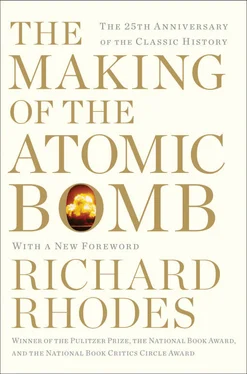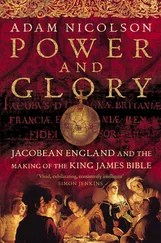Without question Szilard read The Times of September 12, with its provocative sequence of headlines:
THE BRITISH ASSOCIATION

BREAKING DOWN
THE ATOM

TRANSFORMATION OF ELEMENTS
Ernest Rutherford, The Times reported, had recited a history of “the discoveries of the last quarter of a century in atomic transmutation,” including:
THE NEUTRON
NOVEL TRANSFORMATIONS
All of which made Szilard restive. The leading scientists in Great Britain were meeting and he wasn’t there. He was safe, he had money in the bank, but he was only another anonymous Jewish refugee down and out in London, lingering over morning coffee in a hotel lobby, unemployed and unknown.
Then, midway along the second column of The Times’ summary of Rutherford’s speech, he found:
HOPE OF TRANSFORMING ANY ATOM
What, Lord Rutherford asked in conclusion, were the prospects 20 or 30 years ahead? 78
High voltages of the order of millions of volts would probably be unnecessary as a means of accelerating the bombarding particles. Transformations might be effected with 30,000 or 70,000 volts…. He believed that we should be able to transform all the elements ultimately.
We might in these processes obtain very much more energy than the proton supplied, but on the average we could not expect to obtain energy in this way. It was a very poor and inefficient way of producing energy, and anyone who looked for a source of power in the transformation of the atoms was talking moonshine.
Did Szilard know what “moonshine” meant—“foolish or visionary talk”? Did he have to ask the doorman as he threw down the newspaper and stormed out into the street? “Lord Rutherford was reported to have said that whoever talks about the liberation of atomic energy on an industrial scale is talking moonshine. Pronouncements of experts to the effect that something cannot be done have always irritated me.”
“This sort of set me pondering as I was walking in the streets of London, and I remember that I stopped for a red light at the intersection of Southampton Row…. 79I was pondering whether Lord Rutherford might not prove to be wrong.” 80
“It occurred to me that neutrons, in contrast to alpha particles, do not ionize [i.e., interact electrically with] the substance through which they pass. 81
“Consequently, neutrons need not stop until they hit a nucleus with which they may react.”
Szilard was not the first to realize that the neutron might slip past the positive electrical barrier of the nucleus; that realization had come to other physicists as well. But he was the first to imagine a mechanism whereby more energy might be released in the neutron’s bombardment of the nucleus than the neutron itself supplied.
There was an analogous process in chemistry. Polanyi had studied it. 82A comparatively small number of active particles—oxygen atoms, for example—admitted into a chemically unstable system, worked like leaven to elicit a chemical reaction at temperatures much lower than the temperature that the reaction normally required. Chain reaction, the process was called. One center of chemical reaction produces thousands of product molecules. One center occasionally has an especially favorable encounter with a reactant and instead of forming only one new center, it forms two or more, each of which is capable in turn of propagating a reaction chain.
Chemical chain reactions are self-limiting. Were they not, they would run away in geometric progression: 1, 2, 4, 8, 16, 32, 64, 128, 256, 512, 1024, 2048, 4096, 8192, 16384, 32768, 65536, 131072, 262144, 524288, 1048576, 2097152, 4194304, 8388608, 16777216, 33554432, 67108868, 134217736…
“As the light changed to green and I crossed the street,” Szilard recalls, “it… suddenly occurred to me that if we could find an element which is split by neutrons and which would emit two neutrons when it absorbs one neutron, such an element, if assembled in sufficiently large mass, could sustain a nuclear chain reaction. 83, 84
“I didn’t see at the moment just how one would go about finding such an element, or what experiments would be needed, but the idea never left me. In certain circumstances it might be possible to set up a nuclear chain reaction, liberate energy on an industrial scale, and construct atomic bombs.”
Leo Szilard stepped up onto the sidewalk. Behind him the light changed to red.
Atomic energy requires an atom. No such beast was born legitimately into physics until the beginning of the twentieth century. The atom as an idea—as an invisible layer of eternal, elemental substance below the world of appearances where things combine, teem, dissolve and rot—is ancient. Leucippus, a Greek philosopher of the fifth century B.C. whose name survives on the strength of an allusion in Aristotle, proposed the concept; Democritus, a wealthy Thracian of the same era and wider repute, developed it. “ ‘For by convention color exists,’” the Greek physician Galen quotes from one of Democritus’ seventy-two lost books, “ ‘by convention bitter, by convention sweet, but in reality atoms and void.’” From the seventeenth century onward, physicists postulated atomic models of the world whenever developments in physical theory seemed to require them. 85But whether or not atoms really existed was a matter for continuing debate.
Gradually the debate shifted to the question of what kind of atom was necessary and possible. Isaac Newton imagined something like a miniature billiard ball to serve the purposes of his mechanical universe of masses in motion: “It seems probable to me,” he wrote in 1704, “that God in the beginning formed matter in solid, massy, hard, impenetrable, movable particles, of such sizes and figures, and with such other properties, and in such proportion to space, as most conduced to the end to which he formed them.” 86The Scottish physicist James Clerk Maxwell, who organized the founding of the Cavendish Laboratory, published a seminal Treatise on Electricity and Magnetism in 1873 that modified Newton’s purely mechanical universe of particles colliding in a void by introducing into it the idea of an electromagnetic field. The field permeated the void; electric and magnetic energy propagated through it at the speed of light; light itself, Clerk Maxwell demonstrated, is a form of electromagnetic radiation. But despite his modifications, Clerk Maxwell was as devoted as Newton to a hard, mechanical atom:
Though in the course of ages catastrophes have occurred and may yet occur in the heavens, though ancient systems may be dissolved and new systems evolved out of their ruins, the [atoms] out of which [the sun and the planets] are built—the foundation stones of the material universe—remain unbroken and unworn. They continue this day as they were created—perfect in number and measure and weight. 87
Max Planck thought otherwise. He doubted that atoms existed at all, as did many of his colleagues—the particulate theory of matter was an English invention more than a Continental, and its faintly Britannic odor made it repulsive to the xenophobic German nose—but if atoms did exist he was sure they could not be mechanical. “It is of paramount importance,” he confessed in his Scientific Autobiography, “that the outside world is something independent from man, something absolute, and the quest for laws which apply to this absolute appeared to me as the most sublime scientific pursuit in life.” Of all the laws of physics, Planck believed that the thermodynamic laws applied most basically to the independent “outside world” that his need for an absolute required. 88He saw early that purely mechanical atoms violated the second law of thermodynamics. His choice was clear.
Читать дальше













